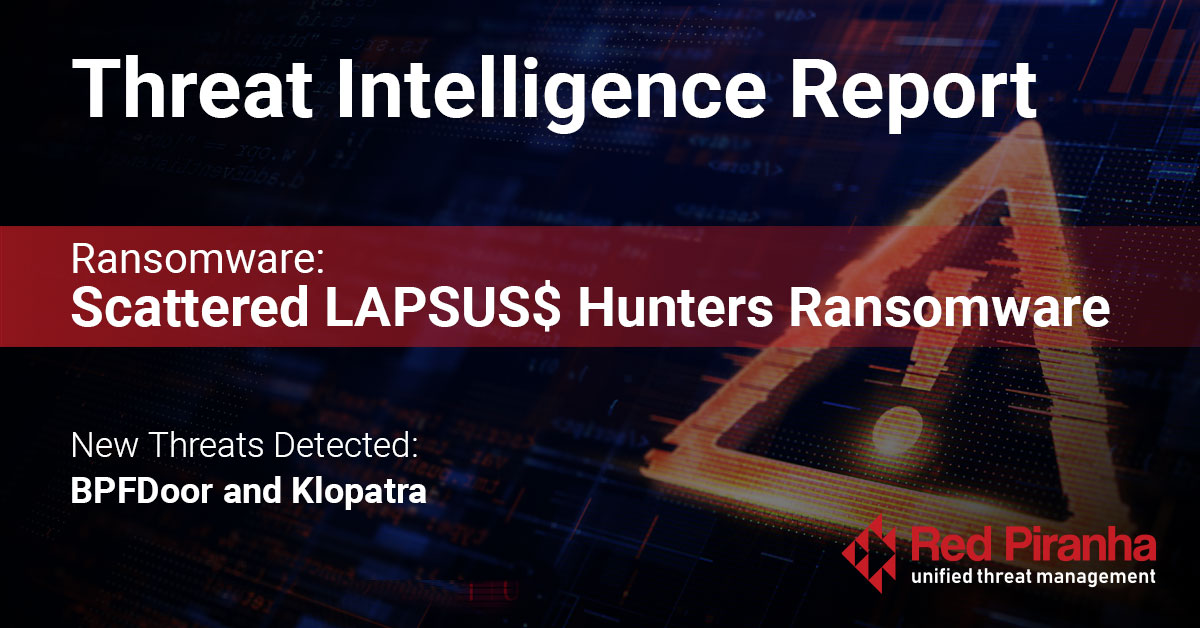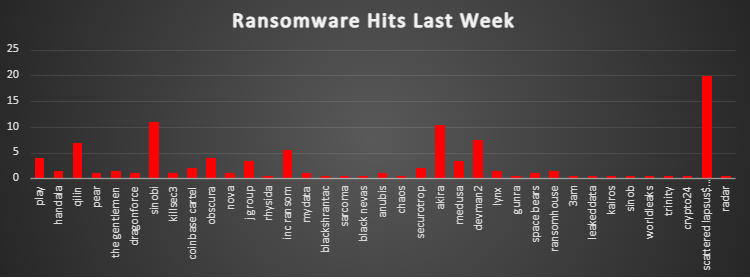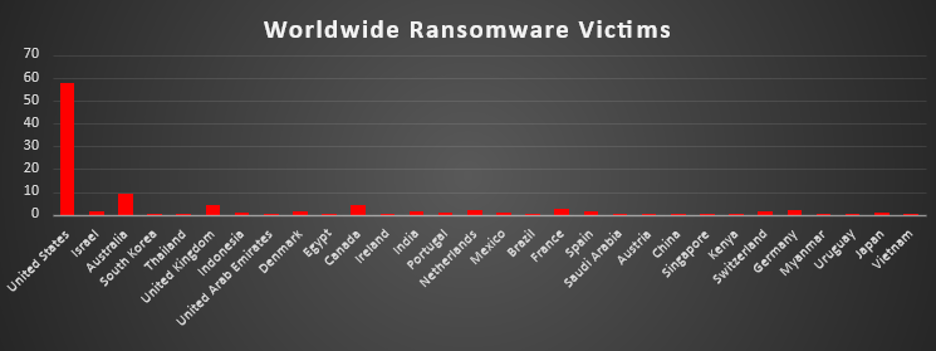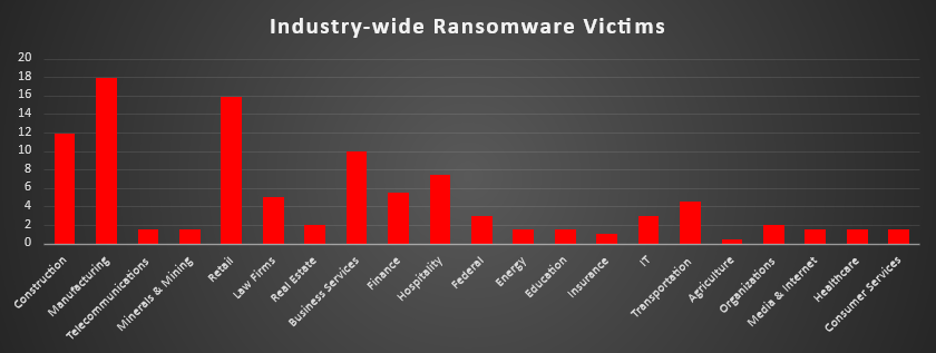
| New Threats Detection Added | • BPFDoor • Klopatra |
|
Detection Summary
|
|
|
Threat Protections Integrated into Crystal Eye
|
105 |
|
Newly Detected Threats
|
6 |
Weekly Detected Threats
The following threats were added to Crystal Eye this week:
|
Threat name:
|
BPFDoor | ||||||||||||||||||
|
BPFDoor is a Linux backdoor malware used by a China-based threat actor. This malware has strong stealth capabilities, using Berkly Packet Filtering (BPF), which allows the malware to execute code into the Linux kernel. This allows the malware to hide its process ID, intercept syscalls, deal with network traffic, and hide kernel modules. The malware supports multiple protocols to interact with a C2 server, including TCP, UDP, and ICMP. All this stealth and communication functionality allows the threats to stealthily infect and laterally move within compromised networks.
|
|||||||||||||||||||
|
Threat Protected:
|
14 | ||||||||||||||||||
|
Rule Set Type:
|
|
||||||||||||||||||
|
Class Type:
|
Command-and-Control | ||||||||||||||||||
|
Kill Chain:
|
|
||||||||||||||||||
|
Threat name:
|
Klopatra | ||||||||||||||||||
|
Klopatra is a new Android-based Remote Access Trojan (RAT). It has been found to target financial institutions and their customers, primarily in Spain and Italy. This malware has strong stealth capabilities due to its use of a code protection system and uses native Android libraries, which reduces the visibility of analysis tools. Due to the language choices and C2 infrastructure, it is suspected that the malware was developed and used by Turkish-based threat actors.
The malware disguises itself as an app for IPTV (Internet based television platform) and once installed, it downloads the Klopatra malware and begins execution. The malware has full access to the entire system, from screen monitoring and input capture to action execution (Simulate taps and gestures).
|
|||||||||||||||||||
|
Threat Protected:
|
06 | ||||||||||||||||||
|
Rule Set Type:
|
|
||||||||||||||||||
|
Class Type:
|
Domain-c2 | ||||||||||||||||||
|
Kill Chain:
|
|
||||||||||||||||||
Known Exploited Vulnerabilities (Week 1 - October 2025)
For more information, please visit the Red Piranha Forum:
https://forum.redpiranha.net/t/known-exploited-vulnerabilities-catalog-1st-week-of-october-2025/601.
|
Threat
|
Description
|
||
|
CVE-2014-6278
|
8.8
|
GNU Bash contains an OS command injection vulnerability which allows remote attackers to execute arbitrary commands via a crafted environment. This vulnerability exists because of an incomplete fix for CVE-2014-6271, CVE-2014-7169, and CVE-2014-6277.
|
|
|
CVE-2017-1000353
|
9.8
|
Jenkins contains a remote code execution vulnerability. This vulnerability that could allowed attackers to transfer a serialised Java object to the remoting-based Jenkins CLI, this allow the existing blocklist-based protection mechanism to be bypassed.
|
|
|
CVE-2025-21043
|
8.8
|
Samsung mobile devices contain an out-of-bounds write vulnerability in libimagecodec.quram.so which allows remote attackers to execute arbitrary code.
|
|
|
CVE-2025-4008
|
8.7
|
Smartbedded Meteobridge contains a command injection vulnerability that could allow remote unauthenticated attackers to gain arbitrary command execution with elevated privileges (root) on affected devices. This is due to an unsafe eval call that is found at /cgi-bin/template.cgi.
|
|
|
CVE-2025-32463
|
9.3
|
Sudo contains an inclusion of functionality from untrusted control sphere vulnerability. This vulnerability could allow local attacker to leverage sudo’s -R (–chroot) option to run arbitrary commands as root, even if they are not listed in the sudoers file.
|
|
|
CVE-2025-59689
|
6.1
|
Libraesva Email Security Gateway (ESG) contains a command injection vulnerability which allows command injection via a compressed e-mail attachment. This occurs due to an improper sanitisation during the removal of active code from files contained in some compressed archive formats.
|
|
|
CVE-2025-10035
|
10
|
Fortra GoAnywhere MFT contains a deserialisation of untrusted data vulnerability allows an actor with a validly forged license response signature to deserialise an arbitrary actor-controlled object, possibly leading to command injection.
|
|
|
CVE-2025-20352
|
7.7
|
Cisco IOS and IOS XE contains a stack-based buffer overflow vulnerability in the Simple Network Management Protocol (SNMP) subsystem that could allow for denial of service or remote code execution. A successful exploit could allow a low-privileged attacker to cause the affected system to reload, resulting in a DoS condition, or allow a high-privileged attacker to execute arbitrary code as the root user and obtain full control of the affected system.
|
|
|
CVE-2021-21311
|
7.2
|
Adminer contains a server-side request forgery vulnerability that, when exploited, allows a remote attacker to obtain potentially sensitive information.
|
Updated Malware Signatures (Week 1 - October 2025)
|
Threat
|
Description
|
|
|
XWorm
|
A Remote Access Trojan (RAT) and malware loader that's commonly used in cyberattacks to give attackers full remote control over a victim's system. It's part of a growing trend of commercialised malware sold or rented on dark web forums, often under the guise of a “legitimate tool.”
|
| Ransomware Report | |
|
The Red Piranha Team conducts ongoing surveillance of the dark web and other channels to identify global organisations impacted by ransomware attacks. In the past week, our monitoring revealed multiple ransomware incidents across diverse threat groups, underscoring the persistent and widespread nature of these cyber risks. Presented below is a detailed breakdown of ransomware group activities during this period. Ransomware Victims – Weekly Overview Scattered Lapsus$ Hunters dominated this week’s ransomware activity, responsible for 19.9% of reported incidents. Its sudden prominence highlights either a large, coordinated campaign or a significant disclosure of past victim compromises. Sinobi (10.95%) and Akira (10.45%) followed closely, showing sustained momentum and reaffirming their place among the top-tier operators. Qilin (6.97%), DevMan2 (7.46%), and Inc Ransom (5.47%) also reported significant activity, contributing to a mid-tier cluster of highly active threat groups. Other notable contributors included Play (3.98%), Obscura (3.98%), J Group (3.48%), and Medusa (3.48%), suggesting focused but smaller-scale operations. A broad range of groups each logged 1–2% of activity, including Coinbase Cartel, Securotrop, RansomHouse, The Gentlemen, Handala, Lynx, Nova, Space Bears, Anubis, and MyData. These actors remain visible but operate at lower volumes compared to leading players. The long tail of groups accounted for 0.5% each, among them Rhysida, BlackShrantac, Sarcoma, Black Nevas, Chaos, Gunra, 3AM, LeakedData, Kairos, Sinob, WorldLeaks, Trinity, Crypto24, and Radar. While individually small, their collective footprint reinforces the fragmented nature of the ransomware landscape, where dozens of actors operate simultaneously at varying scales. |

Scattered LAPSUS$ Hunters Ransomware
Description
Scattered LAPSUS$ Hunters emerged with a coordinated extortion campaign leveraging stolen OAuth tokens and SaaS compromises, primarily targeting Salesforce customers. They published a new leak-site portal listing ~39 high-profile victims across finance, retail, aviation, and tech. The group demanded ransom with a strict deadline, threatening to leak nearly all data records if unpaid. This week marked a clear shift from individual victim extortion toward a SaaS-supply-chain-wide campaign.
Detailed TTPs
Initial Access
- Voice-phishing of helpdesk staff to authorise malicious Salesforce OAuth “Data Loader” apps.
- Supply-chain compromise of Salesloft GitHub repo to steal Salesforce/Google Workspace OAuth tokens.
Detections: New connected apps approved in Salesforce; anomalous MFA resets; GitHub repo access from unknown IP ranges.
Execution
- Abuse of Salesforce Data Loader via stolen tokens to query and pull bulk data.
- Legitimate SaaS APIs (SOQL queries) used to stage exfiltration.
Detections: Sudden high-volume Salesforce API queries; new OAuth client IDs in logs.
Persistence
- Continued use of refreshed OAuth tokens for long-term access.
- No malware persistence—relied on SaaS identity.
Detections: Tokens issued repeatedly from abnormal IP/ASN; OAuth apps persisting in tenant configs.
Privilege Escalation
- Use of already-admin stolen tokens to expand reach into Okta/Azure AD tenants.
Detections: First-time admin logins from suspicious IPs; token scope escalation events.
Defence Evasion
- Tor/VPN use for API calls; blending into legitimate SaaS activity.
Detections: Salesforce/Google Workspace traffic via Tor exit nodes; unusual geos for SaaS API requests.
Credential Access
- Theft of OAuth refresh tokens from Salesloft integration repos.
Detections: GitHub audit logs; token creation without customer initiation.
Discovery
- Enumeration of Salesforce objects (Accounts, Contacts, SSNs, AWS/Snowflake creds).
Detections: Abnormal SOQL query patterns; mass metadata enumeration in API telemetry.
Lateral Movement
- Pivot into Microsoft 365 and Okta via the same token set.
Detections: New admin sessions in AAD/Okta from Tor exit nodes.
Collection/Exfiltration
- Multi-TB exfiltration of Salesforce data via Tor hidden services.
Detections: Large SaaS exports (Drive, SharePoint, Salesforce) from user accounts.
Command & Control
- Leak-site onion portal for comms and extortion negotiations.
- Telegram channels are advertised on the portal.
Detections: Outbound to specific .onion hidden services; new Telegram handles in extortion comms.
Impact
- Threat of releasing ~1 billion Salesforce customer records.
- Victim cards published for Toyota, FedEx, Disney/Hulu, UPS, Aeroméxico, S&P Global, CIC Vietnam, and others.
Detections: Public appearance of victim data on leak portals/forums.
MITRE ATT&CK Mapping
|
Tactic
|
Technique (ID)
|
What it looks like
|
Fast detection
|
|
Initial Access
|
Valid Accounts (T1078)
|
Voice-phishing to approve Salesforce OAuth apps
|
New connected apps approved by end-users
|
|
Initial Access
|
Supply Chain (T1195.003)
|
Salesloft GitHub repo compromised for OAuth tokens
|
GitHub logs showing anomalous repo access
|
|
Credential Access
|
OAuth Token Theft (T1552)
|
OAuth refresh tokens stolen and reused
|
Token use from new IPs/geos
|
|
Execution
|
Command/Script (T1059)
|
Bulk SOQL queries run through Salesforce API
|
Sudden spikes in query logs
|
|
Persistence
|
Valid Accounts (T1078)
|
Reuse of long-lived OAuth tokens
|
Repeated token refresh without user action
|
|
Discovery
|
Account Discovery (T1087)
|
Enumeration of Salesforce objects, SSNs, keys
|
High-volume SOQL queries
|
|
Lateral Movement
|
Remote Services (T1021)
|
Token pivot into Okta/M365
|
First-time admin sessions in Okta/AAD
|
|
Exfiltration
|
Exfil over C2 (T1567.002)
|
Multi-TB SaaS data pulled via Tor/VPN
|
Large egress to Tor exit nodes
|
|
C2
|
Tor (T1572)
|
Use of Tor leak portal for negotiation
|
Tor traffic alerts
|
|
Impact
|
Data Exposure (T1490)
|
Threat to release ~1B Salesforce records
|
Leak-site monitoring
|
IOCs & Samples
Emails/Handles
- shinygroup@onionmail.com
- Telegram: t.me/sh1nygroup
- Telegram: t.me/SLSH6
Domains/Onion
- shinypogk4jjniry5qi7247tznop6mxdrdte2k6pdu5cyo43vdzmrwid.onion
Mitigation (CE 5.5)
- Endpoint: Auto-isolate on shadow-copy deletion/token theft; block new RMM installs.
- Identity: Enforce phishing-resistant MFA; disable legacy auth; revoke high-risk OAuth apps automatically.
- Network: Block Tor/VPN egress; alert on bulk SaaS exports (Salesforce, Drive, SharePoint).
- Detections: Look for first-time admin activity from helpdesk ranges; track “Reset MFA” spikes; monitor large Salesforce API query bursts.
Ransomware Victims Worldwide
The United States continues to dominate global ransomware activity, representing 57.71% of reported victims this week. Its vast digital infrastructure, financial leverage, and reliance on critical supply chains keep it firmly in the crosshairs of ransomware groups.
Australia followed with a significant 8.96%, reaffirming its position as one of the most heavily impacted Asia-Pacific nations. Canada (4.48%) and the United Kingdom (3.98%) also featured prominently, demonstrating steady targeting of North American and European enterprises.
Mid-tier victims included France (2.49%), Germany (1.99%), and the Netherlands (1.99%), alongside India, Spain, Denmark, Switzerland, and Israel (each between 1.49%–1.99%). These figures underscore the persistent targeting of Europe and Asia, particularly industrialised economies with advanced digital ecosystems.
Smaller-scale incidents (around 1%) were spread across Indonesia, Portugal, Mexico, Japan, and Austria, highlighting ransomware’s opportunistic reach.
A broad long-tail of single incidents (0.5% each) was observed in South Korea, Thailand, the United Arab Emirates, Egypt, Ireland, Saudi Arabia, China, Singapore, Kenya, Brazil, Myanmar, Uruguay, and Vietnam. While individually minor, these attacks illustrate ransomware’s ability to reach both mature and emerging markets, reinforcing its global scope.
This distribution once again demonstrates ransomware’s dual targeting pattern: heavy concentration in high-value economies (U.S., Australia, Canada, U.K., Germany, France), paired with opportunistic strikes across a wide range of smaller nations.

Industry-wide Ransomware Victims
Manufacturing remained the most targeted sector this week, representing 17.91% of incidents. Its reliance on legacy systems, operational technology, and intolerance for downtime make it a high-priority target for ransomware groups.
Retail followed closely at 15.92%, reflecting the sector’s heavy reliance on customer-facing systems, payment data, and distributed operations, factors that create numerous vulnerabilities for attackers to exploit. Construction ranked third with 11.94%, a reminder of adversaries’ focus on project-driven industries where operational disruption directly impacts contractual deadlines and financial flows.
Business Services (9.95%) and Hospitality (7.46%) both remained heavily targeted, underscoring attackers’ preference for sectors handling sensitive client information, high transaction volumes, or customer-facing digital systems. Finance accounted for 5.47%, reaffirming its critical role as a high-value extortion target.
Mid-tier incidents were observed across Law Firms (4.98%), Transportation (4.48%), Federal (2.99%), IT (2.99%), Real Estate (1.99%), and Organisations (1.99%). Each of these sectors holds either sensitive legal, regulatory, or operational data, making them attractive despite their lower overall share.
Smaller but still noteworthy targeting included Telecommunications, Minerals & Mining, Media & Internet, Healthcare, Energy, and Consumer Services (each at 1.49%). Insurance reported 1%, while Agriculture registered 0.5%, highlighting ransomware’s broad spread across industries regardless of digital maturity or sector size.
This week’s distribution highlights ransomware’s dual focus: sustained pressure on critical production and customer-facing sectors like manufacturing, retail, and construction, combined with opportunistic attacks across a wide array of industries, ensuring no vertical remains untouched.

